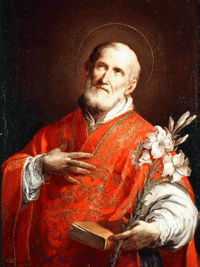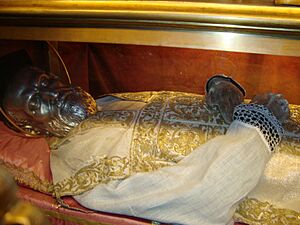Philip Neri facts for kids
Quick facts for kids SaintPhilip Neri Cong. Orat. |
|
|---|---|
 |
|
| Born | 22 July 1515 Florence, Republic of Florence |
| Died | 26 May 1595 Rome, Papal States |
| Venerated in | Catholic Church Church of England |
| Beatified | 11 May 1615 by Pope Paul V |
| Canonized | 12 March 1622 by Pope Gregory XV |
| Feast | 26 May |
| Patronage | Rome, Italy; Candida, Italy; Mandaluyong, Philippines; US Special Forces; Institute of Christ the King Sovereign Priest; Catbalogan, Philippines; laughter; joy; comedians; artists; writers |
Saint Philip Neri (born 22 July 1515, died 26 May 1595) was an Italian priest. Many people called him the "Second Apostle of Rome," after Saint Peter. He is famous for starting a group of priests and brothers called the Congregation of the Oratory.
Contents
Philip Neri's Early Life
Philip was born in Florence, Italy. His father, Francesco, was a lawyer. His mother, Lucrezia, came from a noble family. Philip was raised with care and learned from the friars at San Marco monastery. This was a famous Dominican monastery in Florence.
When he was 18, in 1533, Philip went to live with his uncle, Romolo. Romolo was a rich merchant in a town called San Germano. Philip was supposed to help with the family business. He quickly earned his uncle's trust and affection. However, Philip soon had a strong religious experience. After this, he decided he no longer cared for worldly things. In 1533, he chose to move to Rome to live a religious life.
Starting the Oratory
Helping People in Rome
After moving to Rome, Philip first worked as a tutor for a rich family. For three years, he studied with the Augustinians. After his studies, he began helping the sick and poor. This work later earned him the name "Apostle of Rome."
Around 1538, he started his mission work. He walked all over the city, talking to people. He encouraged them to think about religious topics. For 17 years, Philip lived as a regular person in Rome. He probably didn't plan to become a priest at first. He also met Ignatius of Loyola, who started the Society of Jesus. Many of Philip's followers later joined the Jesuits.
The Holy Trinity Group
In 1548, Philip and his confessor, Persiano Rossa, started a group. It was called the Confraternity of the Most Holy Trinity. This group helped thousands of poor pilgrims who came to Rome. They also helped patients who were leaving hospitals but were still too weak to work. The members of this group met for prayer at a church called San Salvatore in Campo.
The Oratory Begins
In 1551, Philip became a priest. He thought about going to India as a missionary. But his friends convinced him that there was plenty of work to do in Rome. So, he settled down with some friends at a hospital. In 1556, he started the group that became known as the Oratory.
At first, the Oratory was just evening meetings in a hall. They would pray, sing hymns, and read from the Bible. They also discussed religious questions. The musical parts of these meetings were called oratorios. The famous composer Giovanni Palestrina was one of Philip's followers. He wrote music for these services.
The group grew, and its members started doing mission work throughout Rome. They preached sermons in different churches every evening. This was a new idea at the time. Philip also spent a lot of time listening to confessions. He helped many people change their lives through this.
In 1564, Philip was asked to take care of a new church in Rome. It was called San Giovanni dei Fiorentini. He was not sure at first, but Pope Pius IV agreed. Philip accepted the new role but still managed the Oratory meetings at San Girolamo.
The Oratory community grew, and they needed their own church. They were offered the small church of Santa Maria in Vallicella. It was in a good location in the middle of Rome. The old church was too small, so they built a beautiful new one. In 1575, Philip officially organized the group. It became a community of priests called the Congregation of the Oratory. The new church was finished in 1577. Philip himself moved to the new church in 1583. He was chosen to lead the group for life in 1587.
Philip did not want to control other Oratory groups. He wanted each new group to be independent. This rule was later confirmed by Pope Gregory XV in 1622.
Philip Neri's Character

Philip Neri was a unique person. He was very religious but also had a great sense of humor. He believed that being cheerful was more Christian than being sad. He lived his whole life with this spirit. He once said, "A joyful heart is more easily made perfect than a downcast one." This was why he was so popular with the poor people of Rome.
Many amazing things were said to happen around him. After he died, people found that two of his ribs were broken. Some believed this happened because his heart grew bigger when he prayed very strongly. Later, it was thought to be caused by a medical condition. But Philip and his followers believed it was a sign of God's love.
Philip was known for being practical and down-to-earth. He was polite and cheerful. He was interested in what was happening in the world. He dressed neatly and had good common sense. He was a modern gentleman who understood the needs of his time. He knew that old ways of living in monasteries might not work for everyone. He believed that something simpler and more everyday was needed.
Philip often prayed, "Let me get through today, and I shall not fear tomorrow."
Philip Neri's Death and Legacy

Philip Neri died on May 26, 1595. He had spent the day hearing confessions and meeting visitors. Around midnight, he became very ill. He blessed his followers with the sign of the cross and then passed away.
Philip Neri was declared a saint by Pope Gregory XV in 1622. His special day is celebrated on May 26. His body is honored in the Chiesa Nuova ("New Church") in Rome.
Philip Neri was an important person during the Counter-Reformation. He helped many important people in the Church become more holy.
The Oratory Today
The group Philip Neri started is very special. It is not like older monasteries. Its rules allow members a lot of freedom.

The Congregation of the Oratory of Saint Philip Neri is a group of Catholic priests and brothers. They live together in a community but do not take formal vows. They are often called Oratorians. Each Oratory is independent and governs itself. Some Oratories manage churches, while others work with students.
Music and Pilgrimages
Philip Neri loved music. He encouraged singing in his Oratory services. Famous composers like Tomás Luis de Victoria and Giovanni Pierluigi da Palestrina likely took part in this music.
Philip also started a tradition called the "Seven Churches Walk." In 1553, he began leading a one-day pilgrimage to seven churches in Rome. They started at St. Peter's Basilica and ended at the Basilica di Santa Maria Maggiore.
Philip wanted these walks to be fun and spiritual. They helped people share a religious experience and learn about early saints. The route included St. Peter's, St. Paul Outside-the-Walls, St. Sebastian's, St. John Lateran, Holy Cross-in-Jerusalem, St. Lawrence-Outside-the Walls, and St. Mary Major. Philip and his friends would gather before dawn and walk. At each church, they would pray, sing, and listen to a short sermon.
They would also have a simple meal at the gardens of the Villa Mattei. The Mattei family let pilgrims rest there and gave them food and drink. Musicians would play, and singers would perform during these "picnics."
The street connecting Basilica of Saint Paul Outside the Walls with San Sebastiano Fuori le mura is still called "Via Delle Sette Chiese" (Seven Churches Walk). These pilgrimages became very popular. They were a way to have a religious experience that was also joyful and social.
See also
 In Spanish: Felipe Neri para niños
In Spanish: Felipe Neri para niños
- Oratory School
- Saint Philip, patron saint archive
- Seven Churches Visitation
Sources
 This article incorporates text from a publication now in the public domain: Ritchie, C. Sebastian (1911). "St. Philip Romolo Neri". Catholic Encyclopedia 12. New York: Robert Appleton.
This article incorporates text from a publication now in the public domain: Ritchie, C. Sebastian (1911). "St. Philip Romolo Neri". Catholic Encyclopedia 12. New York: Robert Appleton.



